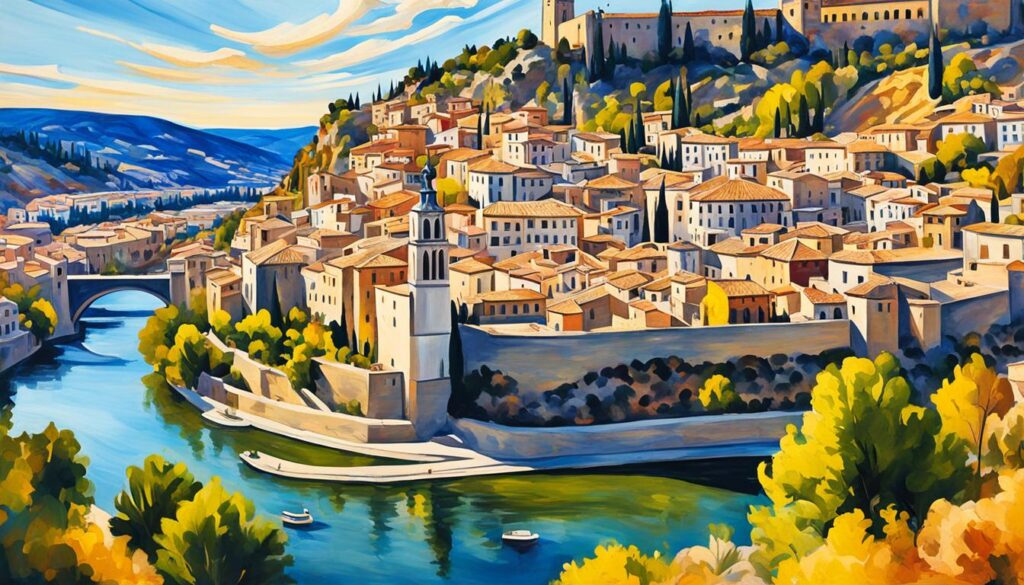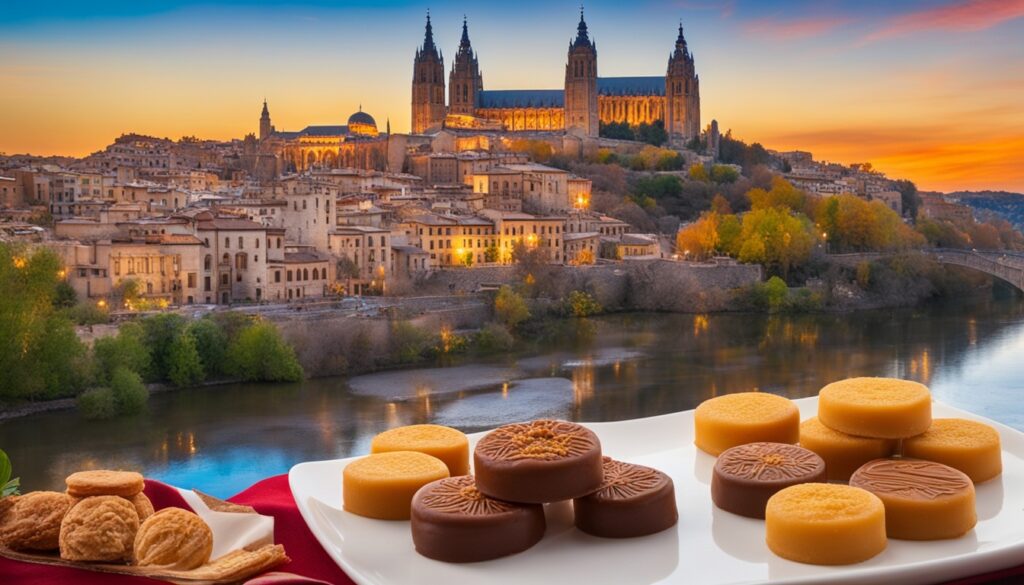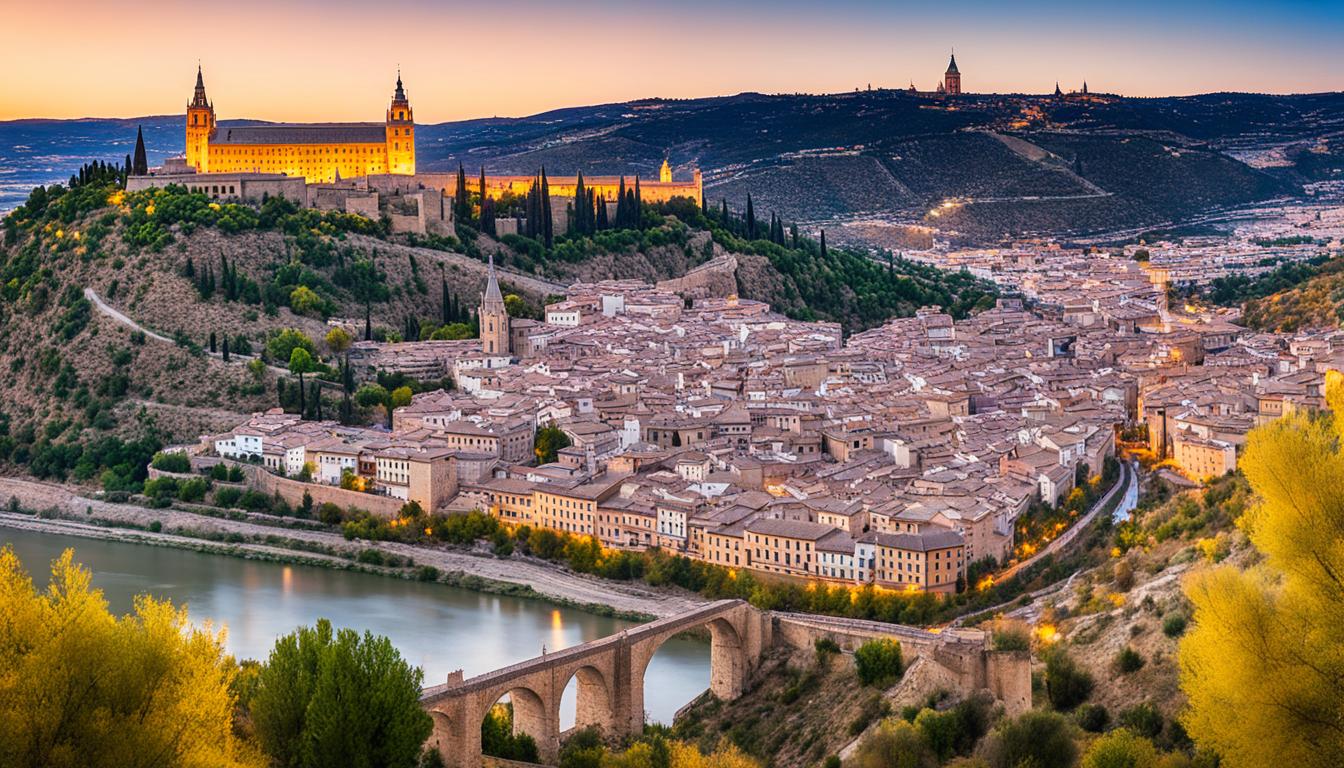Toledo, Spain is a city full of history and culture, just 43 miles south of Madrid. It’s known as the “City of Three Cultures” because of its mix of Christian, Muslim, and Jewish traditions. The city is home to amazing sights like the Alcázar, the Cathedral of Saint Mary, and the Synagogue of El Tránsito.
These landmarks tell the story of Toledo’s rich history. Visitors can dive into centuries of culture and history. They can learn about the city’s ancient blacksmithing or check out the famous Toledo Swords.
Key Takeaways
- Toledo, Spain is a UNESCO World Heritage Site, rich in ancient history and cultural diversity.
- The city’s iconic landmarks, including the Alcázar fortress and the Cathedral of Saint Mary, offer a glimpse into Toledo’s storied past.
- Visitors can explore the city’s Jewish Quarter, discover the legacy of renowned artist El Greco, and savor the traditional marzipan specialty.
- Toledo is an easily accessible day trip destination from Madrid, with convenient transportation options by train, bus, or car.
- The city’s festivals and events, such as the Corpus Christi Festival, showcase the vibrant cultural traditions of Toledo.
Toledo: A UNESCO World Heritage City
Toledo, a city in Spain, was named a UNESCO World Heritage Site in 1986. It’s known for its rich history and cultural importance. The city’s old walls, narrow streets, and stunning medieval buildings show its glorious past. This makes it a must-see for those who love history and architecture.
A Tapestry of Three Cultures
Toledo is called the “city of the three cultures” because of its mix of Christian, Muslim, and Jewish influences. For many years, these three groups lived together in Toledo. This mix is seen in the city’s buildings, art, and traditions. Places like the Toledo Cathedral and the Synagogue of El Tránsito show the city’s diverse heritage.
Medieval Architecture and Narrow Alleys
The old part of Toledo has narrow, winding streets that take you back to medieval times. The city’s skyline is filled with the Alcázar fortress and the big Cathedral of Toledo. These buildings show the city’s architectural beauty. Visitors can see the Puente de Alcántara, a Roman bridge, and the lively Zocodover Square.
“Toledo is a living museum, where the past and present coexist in perfect harmony.”
Getting to Toledo from Madrid
Traveling from Madrid to Toledo is easy with many ways to get there. You can take the train, bus, or rent a car. Each option offers a unique experience to reach this famous Spanish city.
Train, Bus, or Car Rental Options
The high-speed train by Renfe is the quickest way. It takes 30 minutes to get to Toledo, and tickets are about $14 USD one way. ALSA buses are another good choice, costing $12 USD for a round trip and taking about 1.5 hours.
If you want to see the scenery, consider renting a car. The drive from Madrid to Toledo is about an hour. There’s a car park near the Toledo train station, making it easy to walk or use public transport to see the city.
| Transportation Option | Travel Time | One-Way Ticket Price |
|---|---|---|
| High-Speed Train (Renfe) | 30 minutes | $14 USD |
| ALSA Bus | 1.5 hours | $6 USD |
| Rental Car | 1 hour | Varies |
Getting from Madrid to Toledo is now easy with these options. You can pick the train for speed, the bus for savings, or a rental car for freedom. Each way lets you enjoy Toledo’s ancient sights and rich culture easily.
Guided or Independent Day Trip?
Visitors to Toledo, Spain, can choose between a guided tour or an independent day trip. A guided tour offers deep insights that might be missed on your own. Toledo is a top destination in Spain, and a guide can make your visit richer.
Toledo’s history is complex, blending Christian, Jewish, and Muslim cultures over time. A guide can illuminate this heritage. They help you understand the city’s architecture and culture better.
| Guided Tour Toledo | Independent Day Trip Toledo |
|---|---|
|
|
Toledo offers a lot of history, architecture, and culture, whether you go on a guided tour or an independent trip. Your choice depends on how you like to travel and what you want to see. Either way, Toledo is a key place to visit in Spain.
Top Attractions in Toledo
Toledo is a city that mixes old and new beautifully. It’s a UNESCO World Heritage site. Here, you can see the mix of Christian, Muslim, and Jewish cultures in its buildings, art, and traditions. The Puente de Alcántara, Zocodover Square, Toledo Cathedral, and Alcázar Fortress are top places to visit.
Puente de Alcántara and Zocodover Square
The Puente de Alcántara is a beautiful bridge over the Tagus River. It’s a key landmark in Toledo. Near it, Zocodover Square is the heart of the old town. Here, you can walk through narrow streets and feel the city’s lively vibe.
The Magnificent Cathedral and Alcázar Fortress
The Cathedral of Saint Mary is a Gothic gem that towers over the city. It’s famous for its stunning architecture, beautiful stained-glass windows, and Renaissance choir stalls. The Alcázar Fortress is another must-see, with its great views and history.
Toledo is full of medieval architecture and diverse culture. It offers unforgettable experiences for visitors. From the famous Puente de Alcántara to the stunning Cathedral and Alcázar Fortress, Toledo is a true treasure of Spain’s history and culture.
Exploring Toledo’s Jewish Quarter
Toledo is famous for its Jewish Quarter, filled with historical sites. This area was once home to a large Jewish community. They had ten synagogues in the Middle Ages. But, in 1492, they faced expulsion or forced conversion due to persecution.
Monastery of San Juan de los Reyes
The Monastery of San Juan de los Reyes is a key spot in the Jewish Quarter. It’s a 600-year-old Franciscan convent with Gothic, Moorish, and Renaissance styles. You can see a beautiful cloister with stone carvings and a peaceful orange tree garden.
Santa Maria La Blanca and Sinagoga del Tránsito
The Santa Maria La Blanca and Sinagoga del Tránsito synagogues are still standing from the past. The Santa Maria La Blanca was built in the early 13th century but became a Christian church in 1411. The Sinagoga del Tránsito, from 1357, is known for its Mudejar style and stunning decorations. Now, it’s a museum that takes you through Jewish history in Spain.
The Jewish Quarter of Toledo shows the city’s deep cultural roots. Walking through its narrow streets and seeing its landmarks is a journey into Toledo’s history. It’s a place that captures the heart of the city’s past.
The Legacy of El Greco
Toledo, Spain, is a key part of the artistic legacy of Domḗnikos Theotokópoulos, known as El Greco. This city was his main home and where he created some of his most famous works.
El Greco Museum and Santo Tomé Church
In Toledo, you can visit the El Greco Museum. It has many of his paintings, like portraits and decorations for altars. Nearby, the famous painting “The Burial of the Count of Orgaz” by El Greco is in the Santo Tomé Church. This shows his lasting impact in Toledo.

El Greco lived in Toledo from 1577 until his death. He painted many altarpieces and decorative pieces here. He was born in 1541 on the island of Crete and had a child named Jorge Manuel Theotocopoulos with Jerónima de las Cuevas. Sadly, his burial place is unknown.
“El Greco’s style embraced mannerism, characterized by compressed space, bizarre colors, elongated figures, and complex poses.”
After he died, El Greco’s work was forgotten. But it was rediscovered in the 1800s. The National Gallery in London has the biggest collection of his work outside Spain, where he lived most of his life.
Toledo Spain Tourism: Festivals and Events
Toledo, Spain, is alive with color and joy all year round. It hosts many Toledo Spain festivals that draw tourists. The biggest event is Corpus Christi in May/June, with decorated streets and giant puppets. Holy Week before Easter and the Virgen del Sagrario de Toledo on August 15 are also big events.
These Toledo Spain festivals let visitors dive into Toledo’s history and traditions. From the grand Corpus Christi processions to the Holy Week celebrations, each event shows Toledo’s mix of cultures.
| Event | Date | Description |
|---|---|---|
| Corpus Christi | May/June | Decorated streets, processions with giant puppets, and cultural events |
| Holy Week (Semana Santa) | Before Easter | Colorful processions in traditional dress |
| Virgen del Sagrario de Toledo | August 15 | Celebration of the city’s patron saint |
Toledo has Toledo Spain festivals and Toledo Spain events for everyone. Whether you like grand religious events or small community gatherings, there’s something for you. This Spanish city is truly enchanting.
Traditional Cuisine of Toledo
Toledano cuisine is full of flavors, showing off the city’s rich culture. It includes hearty stews and the famous Toledo marzipan. These dishes capture the spirit of this ancient Spanish city.
Marzipan: A Sweet Specialty
Toledo marzipan is a top treat in Toledo. It’s made with ground Marcona almonds and sugar. The Marcona almond gives it a special taste and texture.
But there’s more to Toledo’s food than just marzipan. The city offers many tasty dishes. Stews with local game meats like deer and pig are cooked with many ingredients. These include wine, almonds, saffron, and garlic.
Toledo’s food scene was named Spanish Gastronomy Capital for 2016. This honor highlights its great food culture and events. Visitors can explore traditional markets, taverns, and new restaurants.

Trying Toledo marzipan or enjoying the city’s stews is unforgettable. Toledo’s food scene offers a unique and authentic experience for food lovers.
Toledo’s Unique Fusion of Cultures
Toledo, a UNESCO World Heritage Site, is a city rich in history. It’s a mix of Christian, Muslim, and Jewish cultures. This mix is seen in its beautiful buildings, traditions, and cultural heritage.
The Alcázar fortress and the Cathedral of Saint Mary show the city’s diverse past. The Synagogue of El Tránsito and the Monastery of San Juan de Los Reyes highlight Toledo’s long history.
Toledo is famous for its Damascene metalwork, swords, and marzipan sweets. Being close to Madrid has helped its economy grow. This includes tourism, services, and commerce.
Visitors can feel the blend of cultures in Toledo. They can see medieval buildings, visit important religious sites, or try local foods. The Toledo fusion of cultures leaves a lasting impression.
“Toledo is a living museum, a city where the past and present coexist in perfect harmony, offering visitors a window into the enduring legacy of its diverse cultural influences.”
Conclusion
Toledo, Spain, is a city that takes you back in time. It’s full of history, culture, and stunning architecture. Visitors can see the famous Cathedral of Saint Mary and the Alcázar Fortress. The Jewish Quarter and the works of El Greco are also must-sees.
Whether you join a guided tour or go on your own, Toledo Spain tourism will amaze you. The city’s mix of cultures and its spirit have lasted for centuries. It’s a place where history comes alive.
People in Toledo think a lot about how tourism affects their city. They look at the good and bad sides of it. This helps make plans for the future of tourism in Toledo.
Toledo is getting more popular with tourists who love culture and history. This brings both good things and challenges. Researchers have looked into why people visit Toledo and how to make it better for everyone.
Toledo Spain tourism gives visitors a special chance to see the city’s past. You can walk through old streets, try local food, and see amazing art. Toledo leaves a mark on everyone who visits.

